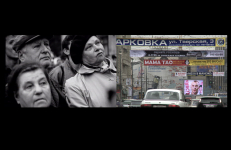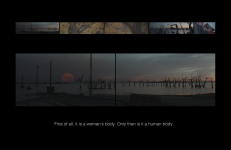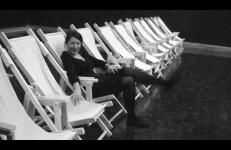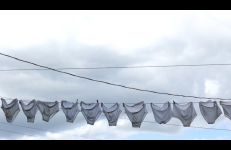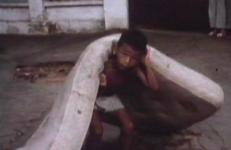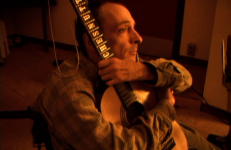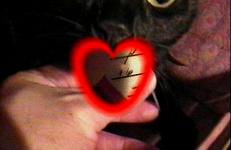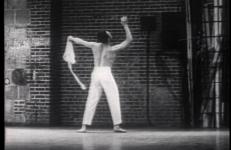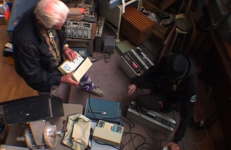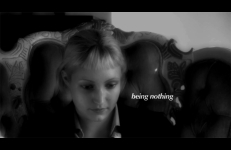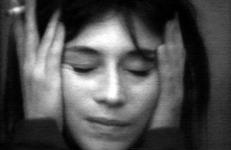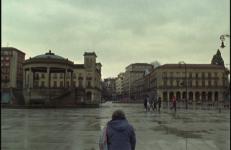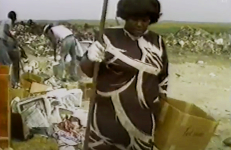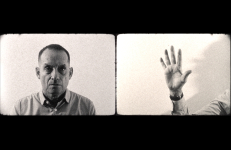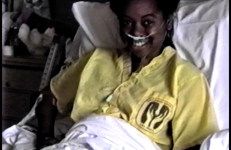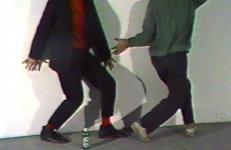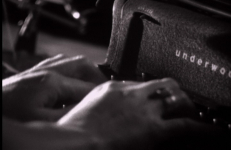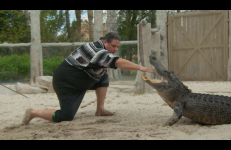In Dani Leventhal's video, 17 New Dam Rd., we are invited along on a house visit with a familial group. There's trash in the garden, guns on the sofa, and marshall arts in the living room. A photo session records a young woman throwing punches at a man, playacting for the camera, but sweating anyway. A kitten ignores the bullets littered on the ground. Despite the foregrounding of violent pursuits, lost teeth and pool hall fights, there's a rough camaraderie here, a feeling of loyalty and belonging.
Portrait
A wide-screen video diptych of scenes shot during two different periods in Moscow––old footage from 1990 and newer from 2009. There's no linear narrative as the "story" is told principally in the juxtaposition of the two images of the city with this almost 20yr gap. It runs 31 minutes as a single screening, but it is meant to be seen as an installation since its visual theme, from an American perspective, is the recurring cycle of Russian upheaval. It is also principally a "fractal" piece, meaning that its story is replicated in every scene.
–– Ken Kobland
The sonic fabric of 2nd Person, [originally] a multi-channel video installation, is formed through an array of women’s voices orchestrated as parallel tracks in a musical composition. The speakers, all women I have intimately known at different points in my life -- my child, my mother, my best friends, students, mentors -- talk with me about aging, growing up, death, motherhood, love and loss.
Mexican video artist Ximena Cuevas documented the preparations and opening of the Marina Abramovic Videoinstalaciones exhibit at Mexico City's Laboratorio Arte ALameda, the first Abramovic exhibition ever to take place in Mexico, in November of 2008. Cuevas captures the self proclaimed "performance grandmother" in a number of personal and performative moments as she readies for the opening.
A brief visit with a graduate student in the painting department of the art college where Kuchar teaches and the discussion that follows the unveiling of his work. Stroll through a gallery of acryllic-rendered innocence gone awry and the yo-yo generation in heat.
A son discreetly records fleeting moments in his parents’ suburban home. An intimate portrait of a stable life lived according to the rules of society.
amaurosis is an experimental documentary about Dat Nguyen, a blind guitarist living in Little Saigon, Orange County, California. Dat Nguyen was a "triple outcast": blind, Amerasian, and an impoverished orphan. His American father left Viet Nam in 1973, and his mother died in 1975. Living on the streets of Saigon, he sold lottery tickets for food money. At the age of 12, Dat met a classical music teacher who was also blind and who taught him to read Braille as well as supported him.
A musical portrait of Vic Chesnutt and company recording the song, CHAIN.
The piece was shot during the recording session for the album, At the Cut, at the Hotel2Tango studio in Montreal, and features appearances by musicians including Efrim Menuck, Guy Picciotto, Jessica Moss, and Chad Jones. CHAIN was written by Chesnutt after viewing Cohen's feature film of that name.
A cold stone structure stands in frigid defiance to the moral decay which shrivels the leaves of erect extensions to the human lust for creative expression. This video portrait of art in the making and cats on the prowl will let out of the bag a Pandora's mix of cat chow and chit chat befitting upright blokes.
This video features California artists: drawer and painter Deanne Belinoff, sculptor and poet Sana Krusoe, wood relief carver and painter Palema Holmes, and New York-based video artist Shirley Clarke.
The Artists: Part 1 was produced in concert with the exhibition Four Solo Exhibitions at the Long Beach Museum of Art in 1988. The artists are introduced by LBMA’s senior curator Josine Ianco-Starrels. The video presents and contrasts the diverse styles, media, and personalities of these four women artists.
Atomic Ed & the Black Hole tells the story of a scientist-turned-atomic junk collector known as Atomic Ed. More than 30 years ago, Ed quit his job making “better” atomic bombs and he began collecting what he calls “nuclear waste,” non-radioactive high-tech discards from the Los Alamos National Laboratory. As the self-appointed curator of an unofficial museum of the nuclear age called “The Black Hole,” Atomic Ed reveals and preserves a history of government waste that was literally thrown in a trash heap.
Spanish subtitled version available.
CB is an experimental bio-pic: its heroine, Charlotte Brontë. A collaboration between Doug Ischar and Tom Daws, CB was commissioned by the Laumeier Museum, St. Louis, for their inaugural Nightlight series.
CB is an experimental bio-pic: its heroine, Charlotte Brontë. A collaboration between Doug Ischar and Tom Daws, CB was commissioned by the Laumeier Museum, St. Louis, for their inaugural Nightlight series.
From 1970 to 1972, Arthur Ginsberg and Video Free America recorded the private life of a not-so-average American couple-Carel Row and Ferd Eggan. She is a porn actress and filmmaker; he is a bisexual junkie. The video verite camera captures the desires and frustrations of their evolving relationship and their responses to the ongoing videotaping exercise. The tape, a study in "the effect of living too close to an electronic medium," reveals attitudes and discussions that also render it a fascinating social document of the west coast counterculture.
Stephen Varble (1946-1984) staged gender-confounding costume performances on the streets of 1970s Manhattan, and he became infamous for his anti-commercial disruptions of galleries, banks, and boutiques. In 1978, he retreated from this public work to focus on the making of an epic, unfinished piece of video art, Journey to the Sun, until his death in the first days of 1984. Lush, ribald, and unorthodox, the video mixed non-narrative costume performances with a surrealist fable of a messianic martyr, the Warbler.
Uncomfortable journeys through the work and ideas of Christopher Cozier, a leading contemporary artist in the Caribbean. The video presents Cozier's witty and incisive drawings, installations and videos in the context of post-independence Trinidad with its oil-rich economy, complicated ethnic politics, and vibrant cultural forms.
A portrait of Luce Vigo, film critic, educator, and the daughter of pivotal French filmmaker Jean Vigo. Commissioned by the Spanish documentary festival, Punto de Vista, the film incorporates Luce's memories of her extraordinary life, reflections on her father, and images of Northern Spain.
“What's junk to some people, is treasure to others,” an idea that motivated the work of humanitarian Dorothy Davis. Dorothy Davis: Make a Way is as much a joyous celebration of spirit as an intimate portrait of Dorothy. This video documents her glorious creations and philosophies on recycling and duty to others. With her husband, Oliver, a scrap merchant, they struggle to provide care for pregnant girls and needy neighbors victimized by an unresponsive welfare system, in spite of their own poverty.
One plus one is two. Two plus two is four. Four plus four is eight. Eight plus eight is sixteen. Sixteen plus sixteen is thirty-two.
I was an Artist in Residence for three months on Five East, the ward for chronically ill adolescents at Children’s Hospital, Los Angeles. Five East is a series of video portraits. I went from room to room on the ward and asked each adolescent if they would like to make a video portrait of themselves. The children had a variety of chronic illnesses including cystic fibrosis and sickle cell anemia. However, I did not ask them to speak about their illness. I let them speak for themselves on whatever might be of interest to them.
Gay Tape: Butch and Femme is Cecilia Dougherty's first video work. She was immersed in two things at the time: making artwork, and being a part of the Oakland, California lesbian bar scene. The tape is the child of those two activities. Dougherty asked her friends, Ann and Joanne, and her girlfriend at the time, Rosa, to speak on camera about dating and the emergence of butch-femme relationships, which alluded to not so much a regression to old-time lesbian subculture, as to a quotation of those times, and an appreciation of that kind of lesbian eroticism.
This fictional memoir gives voice to the woman who haunted Andre Breton's 1927 Surrealist novel Nadja. Speaking from the sanitarium as World War II approaches, she recounts their nine-day love affair in the streets of Paris. Nadja is imaged following the game of exquisite corpse, with staged and framed gestures, excerpts from Surrealist films and archival newsreels as well as fragments from the walks of the filmmaker as flaneur.
A psychedelic portrait exploring epistemologies of Seminole alligator wrestlers. Considered a staple of Florida tourism, alligator wrestling has been performed by members of the Seminole Tribe for over a century. As the practice has changed over the years, Halpate profiles the hazards and history of the spectacle through the words of the tribe's alligator wrestlers themselves and what it has meant to their people's survival.
A psychedelic portrait exploring epistemologies of Seminole alligator wrestlers. Considered a staple of Florida tourism, alligator wrestling has been performed by members of the Seminole Tribe for over a century. As the practice has changed over the years, Halpate profiles the hazards and history of the spectacle through the words of the tribe's alligator wrestlers themselves and what it has meant to their people's survival.
“A soldier’s trip to Syria is complicated when he accidentally impregnates a friend. Meanwhile, a horse breeder from Ohio is driven away from home by her own desire to become pregnant. In Hard as Opal the lines between truth and fiction, fact and fantasy, are reined in and treated not as fixed, divisive markers but as malleable threads of narrative potential. Buckhiester and Leventhal perform alongside other non-actors who are filmed in their own varying domestic and professional environments.





